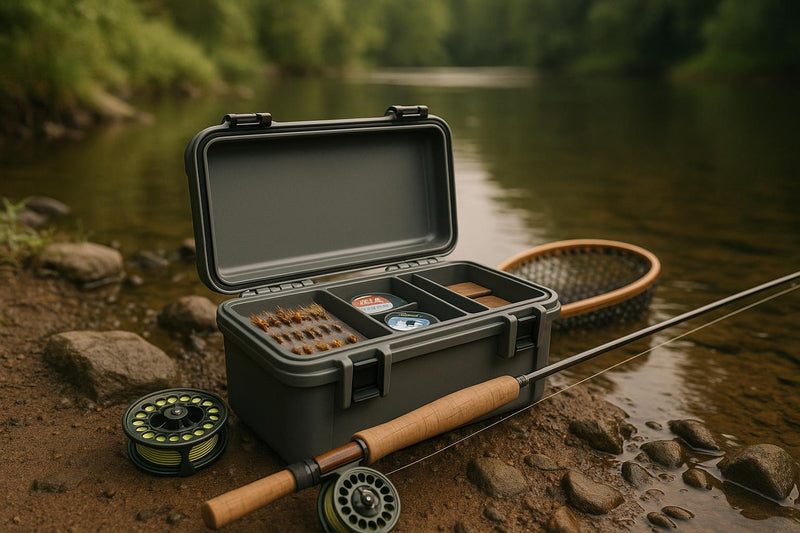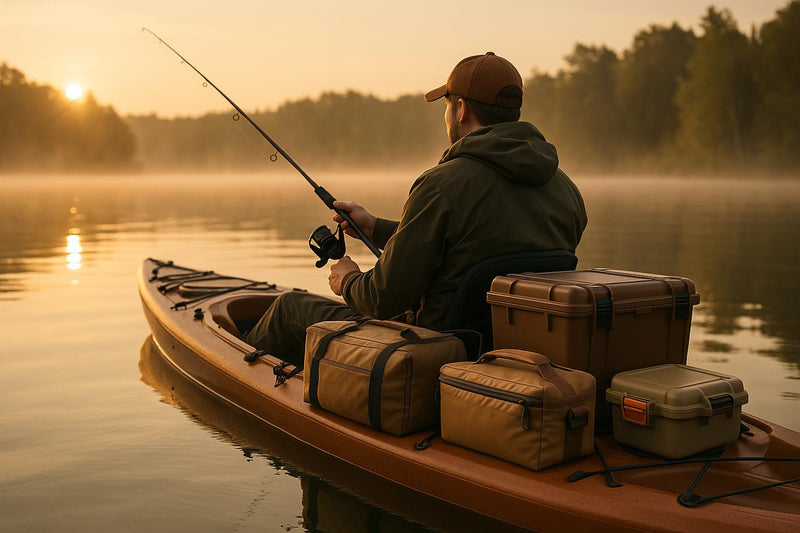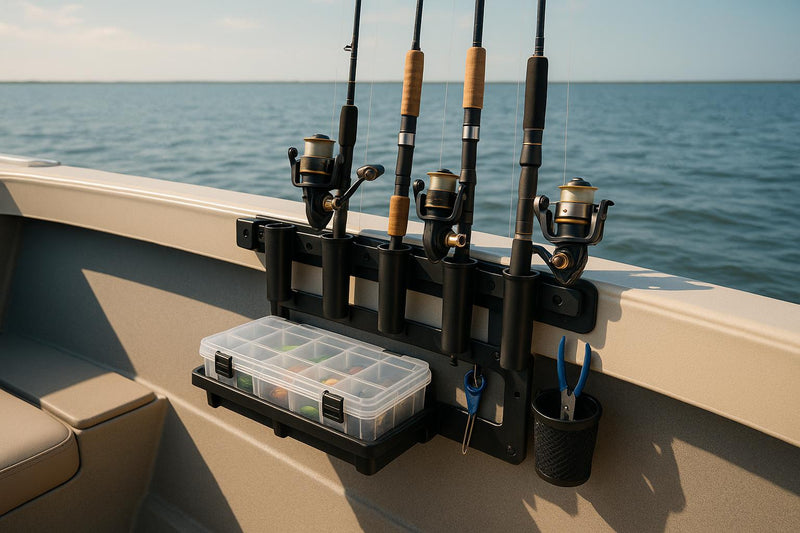Solar rail storage systems combine solar panels with durable storage units to protect fishing gear and power essential devices. These systems are designed for boats and docks, using solar energy to run LED lights, ventilation fans, and charging ports. They shield gear from harsh weather, prevent rust, and support eco-friendly fishing practices. Key components include solar panels, weatherproof storage compartments, and batteries for energy storage. Installation involves mounting the panels, securing the compartments, and connecting electrical components. Regular maintenance, like cleaning panels and inspecting seals, ensures optimal performance.
Key Benefits:
- Protects fishing gear from weather and rust.
- Uses renewable energy for lighting, ventilation, and charging.
- Helps reduce reliance on fossil fuels.
Installation Steps:
- Mount solar panels in sunny areas.
- Secure storage units to rails.
- Wire the system with marine-grade materials.
- Connect batteries and test functionality.
Solar rail storage simplifies gear management while keeping it safe and powered, making fishing trips more efficient and enjoyable.
How Solar Rail Storage Systems Work
Solar rail storage systems blend renewable energy collection with protective storage solutions for fishing gear. These units are typically mounted on boat rails or docks, using sunlight to power features like LED lighting, ventilation fans, and charging ports.
For use in U.S. waters, these systems are designed to fit standard boat rail sizes and are secured with corrosion-resistant, marine-grade stainless steel clamps.
Components of Solar Rail Storage Systems
At the core of these systems is the solar panel assembly, which uses either monocrystalline or polycrystalline panels. The output depends on the size of the unit, and these panels are connected to a charge controller. This controller regulates power flow and prevents battery overcharging during peak sunlight hours.
Storage compartments are crafted from UV-resistant polymers or marine-grade aluminum, ensuring durability in harsh conditions. They are equipped with weatherproof seals and drainage systems to protect the contents. These compartments are spacious enough to store everything from small tackle boxes to larger rod and reel setups, all without requiring overly precise measurements.
The battery system typically includes lithium-ion or AGM deep-cycle batteries, which store energy for use during nighttime or cloudy conditions. Most systems also feature battery level indicators and low-voltage protection circuits, ensuring consistent performance.
Ventilation components, such as small DC fans combined with desiccants, help keep the interior dry. Advanced models even include automatic humidity sensors that activate ventilation when moisture levels rise.
Additional features often include LED strip lighting for nighttime visibility, USB charging ports for electronics, and secure locking mechanisms with marine-grade latches. Wiring is designed for marine environments, using tinned copper conductors with waterproof connectors to ensure reliable operation.
How Energy Is Generated and Utilized
When sunlight hits the solar panels, energy production starts immediately. These panels perform best from mid-morning to early afternoon when the sun is at its peak. Under optimal conditions, the energy generated during the day can power the system’s lighting and ventilation well into the evening.
A charge controller directs excess energy to the battery bank while simultaneously meeting the system’s immediate power needs. Many marine systems use MPPT controllers, which are more efficient at extracting energy compared to standard options.
Energy consumption depends on the system’s features, but critical functions like ventilation and moisture control are prioritized. Once these needs are met, additional energy powers lighting and charging ports, ensuring fishing gear remains protected even during extended periods of low sunlight.
Smart power management features adjust energy usage based on battery levels and weather conditions. For instance, some systems can reduce ventilation cycles or dim lighting during cloudy weather to conserve energy while maintaining essential protective functions.
Benefits of Solar Rail Storage for Fishing Gear
Solar rail storage systems provide an environmentally friendly way to support sustainable fishing practices. By using solar energy, these systems cut down on fossil fuel use and help lower carbon emissions, making them an excellent choice for anglers who care about the planet.
Here’s a closer look at the eco-conscious benefits these systems bring to the table.
Eco-Friendly Advantages
Solar rail storage systems are designed to make the most of renewable energy. As one industry expert explains:
"By providing a stable and efficient mounting solution for solar panels, solar rail storage helps maximize the energy output of solar installations. This maximized energy production means that more electricity can be generated from renewable sources, reducing the reliance on fossil fuels and decreasing carbon footprints."
These systems align seamlessly with sustainable fishing efforts and pair well with gear like premium padded Fishing shorts and Men's Fishing Shorts, offering both comfort and practicality for long days on the water.
Installation Guide for Solar Rail Storage
Set up a solar rail storage system by installing solar panels, securing storage compartments, and connecting the necessary electrical components to protect your gear and enhance functionality.
Choosing the Right System
To pick the right solar rail storage system, you’ll need to consider your boat’s specifics and your fishing requirements. Start by measuring your boat’s rail dimensions to ensure compatibility with the system you plan to install. Think about what you’ll need the system to power - whether it’s LED lighting, charging ports, or climate controls - and choose a system with the right capacity. Keep in mind the boat’s weight distribution when adding equipment to avoid imbalance. Some systems offer clamp-style mounts for quick, non-permanent installation, while others may require a more fixed setup.
Installation Steps
- Position the Solar Panels: Mount the solar panels on unshaded sections of the boat rails to maximize sunlight exposure.
- Attach the Rail Clamps: Space the clamps according to the size of your panels, and tighten them carefully to prevent damage, following the manufacturer’s guidelines.
- Secure Storage Compartments: Use the provided brackets to attach the compartments to the rail system. Place them where they’re easy to access but won’t interfere with your fishing activities.
- Wire the System: Use marine-grade insulated wiring to connect the components. Install the charge controller in a safe, dry location, like inside the cabin or under a console cover.
- Connect Energy Storage (if included): If your system has a battery bank, follow the manufacturer’s instructions to connect it. Place the batteries in a ventilated area away from living spaces.
- Test the System: Before heading out, ensure everything is functioning properly. Confirm the solar panels are generating power, the compartments are secure, and all electrical connections are solid. Use a multimeter to check voltage outputs for accuracy.
Once installed, regular upkeep will keep your system running smoothly.
Maintenance Tips
To maintain peak performance, clean the solar panels regularly, especially after exposure to saltwater. Use fresh water and a soft brush to remove salt and grime. Inspect electrical connections for corrosion or looseness, and address any issues immediately with marine-grade fixes.
Check the waterproof seals on the storage compartments to ensure they remain intact despite exposure to UV rays and temperature changes. If your system includes batteries, monitor their condition and performance as recommended by the manufacturer. Lastly, make sure all mounting hardware is secure before every fishing trip.
A well-maintained solar rail storage system not only protects your gear but also improves your overall fishing experience. And while you’re upgrading your setup, don’t forget to gear up for comfort. Check out our premium Fishing shorts and Mens Fishing Shorts for durability and all-day comfort on the water.
sbb-itb-cb0a783
Using Solar Rail Storage with Angler Comfort Gear
Eco-Friendly Advances in Angler Gear
Solar rail storage systems offer a smart way to protect and power your fishing gear while staying environmentally conscious. By harnessing renewable energy, they keep essential electronics charged without the need for disposable batteries or fuel-powered generators. When paired with advanced angler apparel - like water-resistant, quick-dry fabrics - you get a setup that boosts both performance and sustainability. For instance, combining these storage solutions with Reel Comfort's premium fishing shorts can take your fishing experience to the next level. This pairing highlights how eco-friendly innovations can seamlessly enhance angler gear.
Pairing with Premium Fishing Shorts
Solar rail storage isn’t the only way to upgrade your fishing game. High-quality fishing shorts bring their own set of advantages, blending quick-dry, water-resistant materials with an ergonomic design. Features like removable thigh pads for rod support ensure you stay comfortable, even in unpredictable weather.
The built-in storage pockets on these shorts are perfect for keeping tools like pliers or small accessories within easy reach. Meanwhile, solar rail compartments provide a safe place for sensitive electronics and backup gear, offering a well-rounded solution for marine challenges.
For extended trips, opt for durable men's fishing shorts, designed to handle long days on the water. Together, solar rail storage and premium fishing apparel showcase a modern approach to fishing - where technology, comfort, and eco-conscious choices come together to elevate every outing.
Conclusion: Enhancing Your Fishing Experience with Solar Rail Storage
Solar rail storage systems bring a smart, eco-friendly solution to fishing gear management. By harnessing renewable energy, these systems protect your equipment from the tough marine environment, keep everything organized, and power your essential devices - no need for disposable batteries or fuel.
This setup takes fishing to a new level. Pair it with Fishing shorts designed with removable thigh pads and water-resistant fabric for all-day comfort. Solar rail storage not only keeps your electronics charged but also ensures your gear stays in top condition, while Men’s Fishing Shorts make tools easily accessible, adding convenience to your trip.
By reducing the hassle of gear maintenance, solar rail storage allows you to focus on what really matters - fishing. Combine this technology with thoughtfully crafted apparel, and you’ve got a setup that’s efficient, comfortable, and ready for any adventure.
Ready to upgrade your fishing experience? Explore our collection of Fishing shorts and create a setup that makes every outing more enjoyable and stress-free.
FAQs
How does solar rail storage help protect fishing gear and support eco-friendly practices?
Solar rail storage systems provide a safe and organized way to store fishing gear, keeping equipment protected from tough weather and minimizing the risk of damage. For anglers, these systems add a layer of convenience, making it simpler to access and store gear during outings on the water.
What makes these systems even more appealing is their use of solar energy. By tapping into solar power, they help reduce dependence on fossil fuels and cut down greenhouse gas emissions. This not only supports environmentally friendly fishing but also aligns with broader efforts to safeguard marine ecosystems and encourage responsible fishing practices.
How can I maintain my solar rail storage system to keep it in good condition?
Keeping your solar rail storage system in good shape requires regular upkeep. Aim to inspect it once or twice a year, looking closely for corrosion, loose bolts, or any structural damage. A thorough cleaning to clear away dirt, dust, or debris is also essential to maintain its performance.
Pay attention to all cables, wires, and connections, checking for wear or damage. It's also wise to take precautions against potential threats like storms or pests that might compromise the system. For extra assurance, scheduling periodic professional maintenance can help ensure the system runs efficiently and lasts longer.
How do I choose the best solar rail storage system for my boat and fishing setup?
When choosing a solar rail storage system for your boat, it’s essential to start with a clear understanding of your energy needs. Take a moment to calculate the power usage of all your onboard devices to ensure the system you select can handle the load.
Next, think about the type of mounting. Rail-mounted solar panels are a go-to option because they work seamlessly with standard 1-inch boat rails. Depending on your preferences, you’ll also want to decide between adjustable mounts, which allow you to tweak the panel angles for better sunlight exposure, or fixed mounts, which offer a simpler setup.
By sizing the system correctly and installing it properly, you’ll have a reliable source of power to keep your fishing gear running and make your time on the water more enjoyable.




